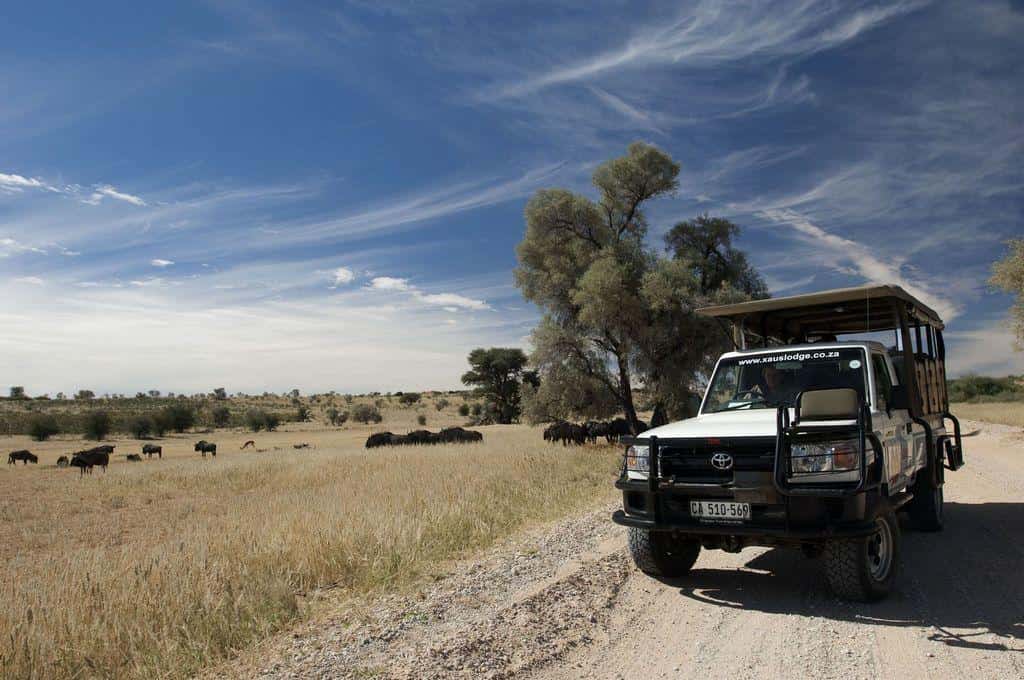The Kgalagadi Transfrontier Park, straddling the border between South Africa and Botswana, is a semi-desert of red dunes and star-crammed skies where African animals run wild and visitors get a wilderness ‘fix’ that’s Prozac for the soul.
Once Kalahari sand gets into your shoes, legend says, you’ll be drawn back again and again.
I’ve visited the park 30 times and even written a book about it. But I lost my heart on my very first visit.
For those who have yet to go there for the first time, here’s some useful information to help with planning a Kgalagadi Transfrontier Park safari.

Getting to the Kgalagadi Transfrontier Park
Take the R360 for 250km from Upington in the Northern Cape, South Africa, via Askham to Twee Rivieren on the South Africa/Botswana border (total distance from Johannesburg 960km; from Cape Town 1100km). If time is short and your pockets deep, fly from Johannesburg or Cape Town to Upington and hire a vehicle there.
Getting around the Kgalagadi Transfrontier Park
I recommend driving a vehicle with high clearance (at least 190mm) or 4×4, especially when the roads are badly corrugated, or muddy in the rainy season (December/January to April). I’ve seen Sedans make it here in the dry season (May to November), but who knows at what cost to their suspension!
A 4×4 is essential for the guided and self-drive 4×4 trails on the South African side, and everywhere on the Botswana/eastern side of the park. Deflate your tyres for a softer ride (and see tip 8 below).
Best time to visit the Kgalagadi Transfrontier Park
Any time is good, depending on what you enjoy. September–November, the end of the dry season, brings animals to the waterholes and many migrant birds. January/February gives lots of action, good raptor sightings and some electric storms, if you don’t mind temperatures of 45–50ºC. If rains have been good, March may show a greener side to the park and it’s good for birding. Steer clear of June/July, if you hate being cold; night-time temperatures can plummet to 0 or -10ºC, although days are sunny.
What to look for during a Kgalagadi Transfrontier Park safari
You’ll almost certainly spot black-maned Kalahari lions and maybe even a leopard, but leave your ‘Big Five’ notions at home as there are no elephant, rhino or buffalo here. Rather, take pleasure in birds of prey, cheetah, hyena, honey badger, bat-eared fox, meerkat and small creatures like whistling rats and barking geckos.
Where to stay the Kgalagadi Transfrontier Park
South Africa:
SAN Parks’ tourist camps (Twee Rivieren, Nossob, Mata Mata) offer self-catering chalets and camping, while their six higher-priced and more exclusive wilderness camps (Gharagab and Bitterpan for 4x4s only) are unfenced for a close-to-nature feel.
The private Xaus Lodge on land returned to the Mier and Khomani San is a fully-catered luxury option.
Kgalagadi Lodge outside the park, 5km south of Twee Rivieren, has self-catering chalets, camping with private facilities,, and a good little restaurant.
Botswana:
Botswana Department of Wildlife and National Parks (DWNP) provides unfenced bush camping with long-drop loos at Rooiputs and Polentswa, and on a range of multi-night trails across the dunes. You must have a 4×4, bring all your own water and be entirely self-sufficient.
At the other end of the scale are the new full-board private lodges at Rooiputs and Polentswa.

Insider tips for visiting the Kgalagadi Transfrontier Park
1. Buy the official info guide to the park at Twee Rivieren for background on the park’s animals, plants and neighbouring San communities.
2. Take warm gear if you visit in winter; use sunscreen and keep hydrated in summer.
3. Rain falls mainly between January and April, though we were once caught in a hail storm in September. The dry season is May to November/December.
4. The safety of the water is suspect. Bring drinking water from home or buy 5-litre jugs of mineral water outside the park where it’s cheaper.
5. You can buy fuel only at Twee Rivieren, Nossob and Mata Mata.
6. Only Twee Rivieren, Nossob and Mata Mata have shops selling bottled water, basic food/toiletries and firewood.
7. Budget for at least one guided early morning walk (R313 a person, no kids under 16) or sunset/night drive (R181 a person, kids half price) during your visit.
8. If you venture out on a 4×4 trail, take a grass net to protect your radiator and deflate your tyres to 1.6 bars or less so you don’t get stuck in thick sand. For safety, travel with at least two vehicles.
9. This is a transfrontier park, but if you want to leave the park somewhere other than where you enter, you mustcomplete immigration formalities at Twee Rivieren/Two Rivers, and stay a minimum of two nights in the park.
10. Kgalagadi isn’t a high-risk malaria area, but use repellents and cover up at dawn/dusk in summer.












